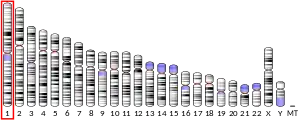C1orf38
Chromosome 1 open reading frame 38 is a protein that in humans is encoded by the C1orf38 gene.[5] The gene is also known as ICB-1 and THEMIS2 in humans, and the orthologue in mice is BC013712.[5] C1orf38 has been associated with cancer susceptibility.[6]
| THEMIS2 | |||||||||||||||||||||||||||||||||||||||||||||||||||
|---|---|---|---|---|---|---|---|---|---|---|---|---|---|---|---|---|---|---|---|---|---|---|---|---|---|---|---|---|---|---|---|---|---|---|---|---|---|---|---|---|---|---|---|---|---|---|---|---|---|---|---|
| Identifiers | |||||||||||||||||||||||||||||||||||||||||||||||||||
| Aliases | THEMIS2, C1orf38, ICB-1, thymocyte selection associated family member 2, ICB1, Chromosome 1 open reading frame 38 | ||||||||||||||||||||||||||||||||||||||||||||||||||
| External IDs | OMIM: 617856 MGI: 2446213 HomoloGene: 21009 GeneCards: THEMIS2 | ||||||||||||||||||||||||||||||||||||||||||||||||||
| |||||||||||||||||||||||||||||||||||||||||||||||||||
| |||||||||||||||||||||||||||||||||||||||||||||||||||
| |||||||||||||||||||||||||||||||||||||||||||||||||||
| |||||||||||||||||||||||||||||||||||||||||||||||||||
| |||||||||||||||||||||||||||||||||||||||||||||||||||
| Wikidata | |||||||||||||||||||||||||||||||||||||||||||||||||||
| |||||||||||||||||||||||||||||||||||||||||||||||||||
Model organisms
| Characteristic | Phenotype |
|---|---|
| Homozygote viability | Normal |
| Fertility | Normal |
| Body weight | Normal |
| Anxiety | Normal |
| Neurological assessment | Normal |
| Grip strength | Normal |
| Hot plate | Normal |
| Dysmorphology | Normal |
| Indirect calorimetry | Normal |
| Glucose tolerance test | Normal |
| Auditory brainstem response | Normal |
| DEXA | Normal |
| Radiography | Normal |
| Body temperature | Normal |
| Eye morphology | Normal |
| Clinical chemistry | Normal |
| Haematology | Normal |
| Peripheral blood lymphocytes | Normal |
| Micronucleus test | Abnormal |
| Heart weight | Normal |
| Tail epidermis wholemount | Normal |
| Skin histopathology | Normal |
| Brain histopathology | Normal |
| Eye histopathology | Normal |
| Salmonella infection | Normal[7] |
| Citrobacter infection | Normal[8] |
| All tests and analysis from[9][10] | |
Model organisms have been used in the study of C1orf38 function. A conditional knockout mouse line, called BC013712tm1a(KOMP)Wtsi[11][12] was generated as part of the International Knockout Mouse Consortium program — a high-throughput mutagenesis project to generate and distribute animal models of disease to interested scientists.[13][14][15]
Male and female animals underwent a standardized phenotypic screen to determine the effects of deletion.[9][16] Twenty six tests were carried out on mutant mice and one significant abnormality was observed: chromosomal instability was detect by a micronucleus test.[9]
References
- GRCh38: Ensembl release 89: ENSG00000130775 - Ensembl, May 2017
- GRCm38: Ensembl release 89: ENSMUSG00000037731 - Ensembl, May 2017
- "Human PubMed Reference:". National Center for Biotechnology Information, U.S. National Library of Medicine.
- "Mouse PubMed Reference:". National Center for Biotechnology Information, U.S. National Library of Medicine.
- "Chromosome 1 open reading frame 38". Retrieved 2011-12-07.
- Springwald, A.; Lattrich, C.; Seitz, S.; Ortmann, O.; Treeck, O. (2009). "Single Nucleotide Polymorphisms in Human Gene icb-1 and Breast Cancer Susceptibility". Cancer Investigation. 27 (6): 669–672. doi:10.1080/07357900802620877. PMID 19308812. S2CID 205570175.
- "Salmonella infection data for BC013712". Wellcome Trust Sanger Institute.
- "Citrobacter infection data for BC013712". Wellcome Trust Sanger Institute.
- Gerdin AK (2010). "The Sanger Mouse Genetics Programme: High throughput characterisation of knockout mice". Acta Ophthalmologica. 88: 925–7. doi:10.1111/j.1755-3768.2010.4142.x. S2CID 85911512.
- Mouse Resources Portal, Wellcome Trust Sanger Institute.
- "International Knockout Mouse Consortium". Archived from the original on 2012-05-29. Retrieved 2012-02-16.
- "Mouse Genome Informatics".
- Skarnes, W. C.; Rosen, B.; West, A. P.; Koutsourakis, M.; Bushell, W.; Iyer, V.; Mujica, A. O.; Thomas, M.; Harrow, J.; Cox, T.; Jackson, D.; Severin, J.; Biggs, P.; Fu, J.; Nefedov, M.; De Jong, P. J.; Stewart, A. F.; Bradley, A. (2011). "A conditional knockout resource for the genome-wide study of mouse gene function". Nature. 474 (7351): 337–342. doi:10.1038/nature10163. PMC 3572410. PMID 21677750.
- Dolgin E (2011). "Mouse library set to be knockout". Nature. 474 (7351): 262–3. doi:10.1038/474262a. PMID 21677718.
- Collins FS, Rossant J, Wurst W (2007). "A Mouse for All Reasons". Cell. 128 (1): 9–13. doi:10.1016/j.cell.2006.12.018. PMID 17218247. S2CID 18872015.
- van der Weyden L, White JK, Adams DJ, Logan DW (2011). "The mouse genetics toolkit: revealing function and mechanism". Genome Biol. 12 (6): 224. doi:10.1186/gb-2011-12-6-224. PMC 3218837. PMID 21722353.
Further reading
- Treeck, O.; Springwald, A.; Konwisorz, A.; Lattrich, C.; Goerse, R.; Ortmann, O.; Treeck, O. (2011). "Silencing of the icb-1 gene inhibits the induction of differentiation-associated genes by vitamin D3 and all-trans retinoic acid in gynecological cancer cells". International Journal of Molecular Medicine. 28 (1): 121–127. doi:10.3892/ijmm.2011.663. PMID 21455565.
- Springwald, A.; Lattrich, C.; Skrzypczak, M.; Goerse, R.; Ortmann, O.; Treeck, O. (2010). "Icb-1Gene Expression is Elevated in Human Endometrial Adenocarcinoma and is Closely Associated with HER2 Expression". Cancer Investigation. 28 (9): 904–909. doi:10.3109/07357907.2010.483511. PMID 20569072. S2CID 35017943.
- Konwisorz, A.; Springwald, A.; Haselberger, M.; Goerse, R.; Ortmann, O.; Treeck, O. (2009). "Knockdown of ICB-1 gene enhanced estrogen responsiveness of ovarian and breast cancer cells". Endocrine-Related Cancer. 17 (1): 147–157. doi:10.1677/ERC-09-0095. PMID 19942713.



